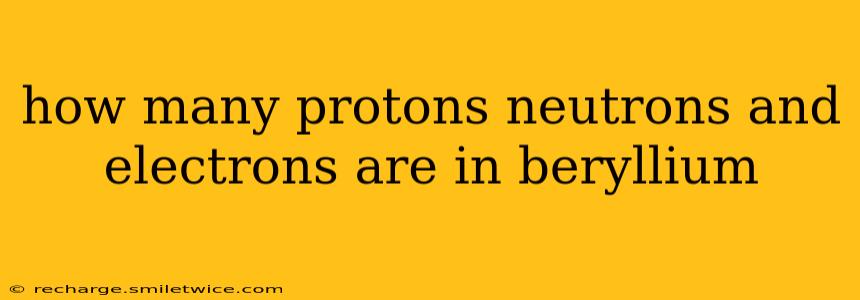How Many Protons, Neutrons, and Electrons are in Beryllium?
Beryllium, a fascinating alkaline earth metal, has a unique atomic structure. Understanding its composition of protons, neutrons, and electrons is key to grasping its chemical behavior and properties. Let's delve into the details.
What is the Atomic Number of Beryllium?
The atomic number of an element defines the number of protons in its nucleus. Beryllium's atomic number is 4. This means every beryllium atom contains 4 protons.
How Many Electrons Does Beryllium Have?
In a neutral atom, the number of electrons is equal to the number of protons. Therefore, a neutral beryllium atom also has 4 electrons. This arrangement of electrons in its shells determines its reactivity and how it interacts with other elements.
Determining the Number of Neutrons in Beryllium
The number of neutrons is slightly more complex. It's not directly determined by the atomic number but rather by the mass number (A) of the isotope. The mass number represents the total number of protons and neutrons in an atom's nucleus. Beryllium has several isotopes, meaning atoms with the same number of protons but a different number of neutrons. The most common isotope is Beryllium-9.
To find the number of neutrons, subtract the atomic number (number of protons) from the mass number.
For Beryllium-9:
- Mass number (A) = 9
- Atomic number (Z) = 4
- Number of neutrons = A - Z = 9 - 4 = 5 neutrons
Therefore, the most common isotope of Beryllium (Beryllium-9) contains 4 protons, 5 neutrons, and 4 electrons.
What about other Beryllium Isotopes?
While Beryllium-9 is the most prevalent, other isotopes exist, each with a different number of neutrons. These isotopes have different mass numbers and slightly different properties. However, they all share the same number of protons (4) and electrons (4) in their neutral state.
How Many Protons, Neutrons, and Electrons are in a Beryllium Ion?
It's crucial to remember that these numbers apply to neutral beryllium atoms. If beryllium loses or gains electrons, it becomes an ion, and the number of electrons will change. For instance, a Be²⁺ ion (a beryllium ion with a +2 charge) would have lost two electrons, leaving it with only 2 electrons, while the number of protons (4) and neutrons (depending on the isotope) remain unchanged.
This detailed breakdown should clarify the proton, neutron, and electron counts within beryllium atoms and ions. Remember to always consider the specific isotope when determining the number of neutrons.
